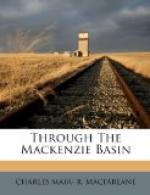We were now approaching Vermilion, the banks of the river constantly decreasing in height as we descended, until they became quite low. Beneath a waning moon in the south, and an exquisite array of gold and scarlet clouds in the east, which dyed the whole river a delicate red, we floated down to the hamlet of Vermilion. The place proved to be a rather extensive settlement, with yellow wheat-fields and much cattle, for it is a fine hay country. The pioneer Canadians at Vermilion were the Lawrence family, which has been settled there for over twenty years. They were original residents of Shefford County, Eastern Townships, and set out from Montreal for Peace River in April, 1879, making the journey to Vermilion, by way of Fort Carlton, Isle a la Crosse and Fort McMurray, in four months and some ten days. The elder Mr. Lawrence had been engaged under Bishop Bompas to conduct a mission school at Chipewyan, but after a time removed to Vermilion, where he organized another school, which he conducted until 1891. He then resigned, and began farming on his own account, and, by and by, with great pains and expense, brought in a flour mill, whose operation stimulated settlement, and speedily reduced the price of flour from $25 to $8 a sack. Unfortunately, this useful mill was burnt in April preceding our visit. The yield of grain, moreover, most of it wheat, was estimated at 10,000 bushels, and the turning of the mill was therefore not only a great loss to Mr. Lawrence, but a severe blow to the place. The population interested in farming was estimated at about three hundred souls, thus forming the nucleus of a very promising settlement, now, of course, at its wits’ end for gristing. Vermilion seemed to be a very favourable supply point in starting other settlements, being in touch by water with Loon River, Hay River, and other points east and north, where there is abundance of excellent land. For the present, and pending railway development, it was plain that the great and pressing requirement of the region was a good waggon road by way of Wahpooskow to Athabasca Landing, a distance of three hundred miles, thus avoiding the dangerous rapids of the Athabasca, or the long detour by way of Lesser Slave Lake, and making communication easy in winter time.
From Mr. Erastus Lawrence, the head of the family, we got definite information regarding the region and its prospects for agriculture. We spent Sunday at his comfortable home, and examined his farm carefully. In front of the house was a field of wheat, 110 acres in extent, as fine a field as we had ever seen anywhere, and of this they had not had a failure, he said, during all their farming experience, the return never falling below fourteen bushels to the acre, in the worst of years, twenty-five being about the average yield. They sowed late in April, but reaped generally about the 15th of August. They had never, he said, been seriously injured by frost since 1884, and in fact no frost had occurred to injure wheat since 1887. There was abundance of hay, and 10,000 head of stock, he believed, could be raised at that very point. Many hogs were raised, with great profit, bacon and pork being, of course, high-priced. One of the sons, Mr. E. H. Lawrence, said he had raised sixteen pigs, which at eighteen months dressed 370 pounds apiece. At that time there were about 500 head of cattle, 250 horses, and 200 pigs in the settlement.




